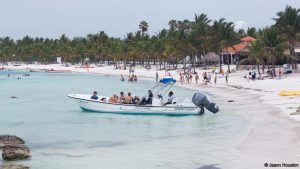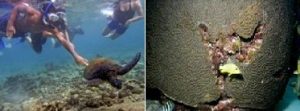Tourism is killing coastlines worldwide, destroying crucial coral reefs and the immense diversity within these ecosystems. Humans are irreversibly changing the marine environment!
There is a modern urge to travel the world; tropical, coastal areas increasingly visited for the sun and climate. More money in these regions puts natural systems at-risk, increased development and uncontrolled tourism affecting ecosystems such as coral reefs. Tourism has the ability to severely degrade coral reefs, introduced below (4earthTV, 2016).
Akumal Case Study
Akumal, Mexico, is an example of a coastline and reef ravaged by tourism. The number of hotel rooms in the region has increased by 80,000 in the last 30 years (Gil et al, 2015).
I have seen for myself the extent of the local environment change, which has had obvious negative effects on the health of the Mesoamerican barrier reef (BBC Earth, 2014).
In Akumal’s popular snorkeling areas, coral cover declined by 79% between 2011 and 2014. Globally, holiday activities have negative effects on the coral and on the native reef species (Gil et al, 2015). Turtle and shark populations suffer increased stress as tourism and tourists dominate the coastline (Constantine, 2001). Coral reefs are very sensitive to rapid tourism development, the popularity of these areas increasing algal cover and coral disease in the community (Garpow, 1999).

Hotel Pollution
Another consequence of global change are the septic tanks from growing hotel complexes, which feed coral reefs with nutrients, boosting the growth of algae and negatively changing the system. This clouds the water, meaning sunlight cannot reach the coral, causing unhealthy reef conditions (Garpow, 1999). Tourists are a huge environmental change impacting coral reefs. Coastal resorts attract the greatest number of tourists annually, often because of our growing desire to view coral reefs (Davenport & Davenport, 2006).
SCUBA Divers and Snorkelling
Worldwide, SCUBA divers and swimmers can severely damage the reef – in crowded areas, coral contact can lead to 100% mortality (Reef Resilience, 2016), inflicting abrasion and tissue loss (Davenport & Davenport, 2006). Tourists can also suffocate the coral, stirring up silt and encouraging algal domination. Coral reefs are also experiencing more boat traffic, which can disrupt coral communities, upsetting species interactions. Using boat anchors on the reef can damage the coral for decades, lowering reproductive health and species fitness (Rogers and Garrison, 2001).

The Future of Coral Reefs
There are global plans to increase tourism around coral reefs, building additional hotels. Human pollution will increase; sun-cream and E. coli contamination expected to impact reef health. Marine turtles are also developing tumours from a tourism-borne virus, demonstrating the reduced health of coral reefs and the species within them; all because of tourism (Sanchez-Navarro Russell, 2016).
Coral reefs across the world are experiencing problems associated with tourism. Fifty years ago reefs were untouched; only in the last 30 years have coral reefs become a primary tourist attraction. The coastline has changed so dramatically that slow-growing coral and the species within them cannot adapt fast enough and are suffering greatly.
Tourism has the potential to kill existing coral reefs; therefore, it is our responsibility to manage coastlines with greater effect, and as tourists, show greater respect towards the marine environment.
[483 words]
References
BBC Earth. (2014). The Struggle to Save the Caribbean’s Huge Barrier Reef. Available: http://www.bbc.co.uk/earth/story/20141128-the-other-great-barrier-reef. Last accessed 13th March 2017
Constantine (2001), Increased Avoidance of Swimmers by Bottlenose Dolphins (Tursiops truncatus) due to Long-Term Exposure to Swim-With-Dolphin Tourism, Marine Mammal Science. 17 (4), p689-702.
Davenport and Davenport (2006), Impact of Tourism and Personal Leisure Transport on Coastal Environments: A Review. Estuarine, Coastal and Shelf Science. 67, p280-292.
Garpow, W (1999), Sustainability Indicators Regarding Tourism Development and Coral Reef Conservation: A Case Study of Akumal in the Caribbean, Proceedings of the 1999 Northeastern Recreation Research Symposium. P23-29.
Gil et al (2015), Rapid Tourism Growth and Declining Coral Reefs in Akumal Mexico, Marine Biology. 162 (11), p2225-2233
Reef Resilience (2016), Tourism and Recreational Impacts. Available: http://www.reefresilience.org/coral-reefs/stressors/local-stressors/coral-reefs-tourism-and-recreational-impacts/. Last accessed 13th March 2017.
Rogers and Garrison (2001), Ten Years after the Crime: Lasting Effects of Damage from a Cruise Ship Anchor on a Coral Reef in St. John, U.S. Virgin Islands. Bulletin of Marine Science. 69 (2), p793-803.
Sanchez-Navarro Russell (2016), Akumal Suffering from Unsustainable Growth. Available: http://mexiconewsdaily.com/opinion/akumal-suffering-from-unsustainable-growth/. Last accessed 13th March 2017.
4earthTV. (2016). Coral Reef Conservation: 4earthTV. Available: https://www.youtube.com/watch?v=OGcnzggMqKA. Last accessed 22nd March 2017.
Recent Comments